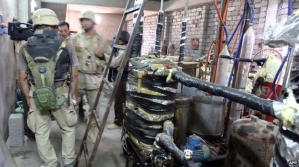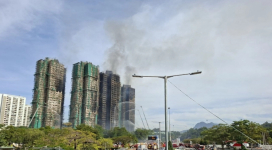
Disturbing visual evidence reveals that the Islamic State terrorist group may have used Saddam Hussein's leftover chemical weapons on Kurdish fighters.
The pictures, provided by the Middle East Review of International Affairs, were published in a report by the Global Research in International Affairs (GLORIA) on Sunday. The photos include disturbing images of mutilated bodies of Kurdish fighters of the Kurdish People's Protection Unit (YPG) that experts believe may have been caused by chemical weapons.
According to the New York Times, United States and Iraqi troops encountered over 5,000 chemical warheads, aviation bombs and shells in Iraq from 2004 to 2011 which are believed to be left behind from the rule of Saddam Hussein.
The health minister of the Kurdish authority in Kobane, Nisan Ahmed, said that the scars and mutilations shown on the bodies of Kurdish victims indicate ISIS's use of chemical weapons.
"Burns and white spots on the bodies of the dead indicated the use of chemicals, which led to death without any visible wounds or external bleeding," Ahmed told the New York Times.
Both the New York Times and the GLORIA added that a letter was sent this summer that claims that over 2,500 corroded chemical weapons containing the nerve-agent Sarin remained at the ruins of the Muthanna State Establishment, which is now under the authority of the Islamic State.
According to a United Nations report, within bunker 41 alone there were "2,000 empty 155mm artillery shells contaminated with the chemical warfare agent mustard, 605 one-tonne mustard containers with residues, and heavily contaminated construction material"--all of which still pose a threat.
The Times reported that the U.S. government had known of the discoveries of chemical weapons in Iraq, and the fact that they are harming U.S. troops, since 2003 when troops invaded the country under the command of President Bush. The New York Times also claimed the government had kept the findings hidden.
Former Army sergeant Jarrod Taylor told the Times that the public was fooled for years.
"I love it when I hear, 'Oh there weren't any chemical weapons in Iraq,' " Taylor said. "There were plenty."
Retired Army Major Jarrod Lampier told The New York Times that after taking part in the largest chemical weapons discovery in Iraq, where 2,400 nerve-agent rockets were found in 2006, he and the other troops were ordered not to talk about the discovery.
"Nothing of significance is what I was ordered to say," Lampier said.
Others told the Times that the U.S. may have hidden the findings because most of the incidents in which coalition forces were wounded by chemical weapons involved munitions designed by the U.S.
Rear Admiral John Kirby did not comment on the findings, but said that a review had been launched to ensure military members were provided proper medical care.







